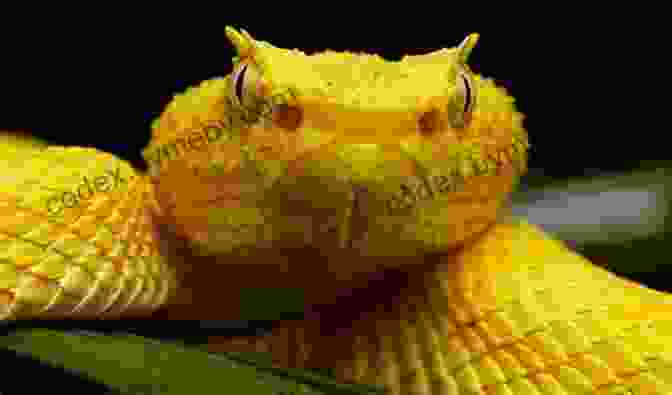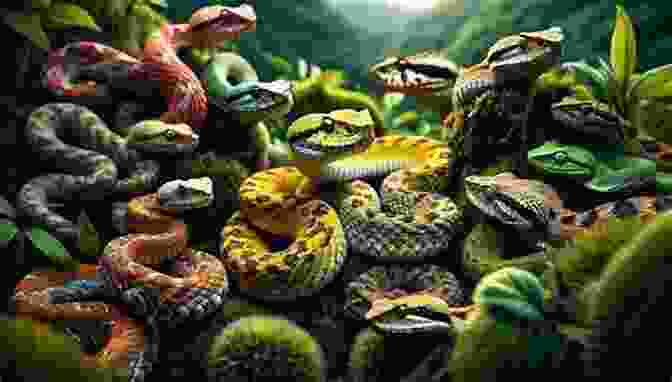Enter the World of Pit Vipers: A Comprehensive Guide for Kids

Step into the captivating world of pit vipers, where danger and beauty intertwine. These fascinating snakes hold a unique place in the animal kingdom, possessing a distinct set of characteristics that set them apart from other snakes.

5 out of 5
| Language | : | English |
| File size | : | 733 KB |
| Text-to-Speech | : | Enabled |
| Screen Reader | : | Supported |
| Enhanced typesetting | : | Enabled |
| Word Wise | : | Enabled |
| Print length | : | 29 pages |
| Lending | : | Enabled |
Unveiling the Pit Viper's Secrets
One of the most striking features of pit vipers is their namesake pit, a small, heat-sensitive organ located between their nostrils and eyes. This remarkable adaptation allows them to detect warm-blooded prey, such as rodents and birds, even in complete darkness.
Beneath their menacing fangs, pit vipers possess a potent venom that serves as a formidable defense mechanism. Their venom is primarily hemotoxic, meaning it attacks the victim's blood cells and tissues, causing pain, swelling, and potential tissue damage.
Exploring the Pit Viper's Habitat
Pit vipers inhabit a wide range of environments, from dense forests and grasslands to rocky outcrops and deserts. They are found on every continent except Antarctica, with the greatest diversity occurring in Southeast Asia.
These snakes prefer warm, humid climates, but some species have adapted to colder regions. For instance, the common European adder (Vipera berus) can withstand freezing temperatures by hibernating during the winter months.
Unveiling the Pit Viper's Diet
Pit vipers are primarily carnivorous, with a diet consisting mainly of small mammals, birds, and amphibians. Using their heat-sensing pits, they can locate prey even in low-light conditions or complete darkness.
Their hunting technique involves a stealthy approach, followed by a swift, venomous strike. Once their prey is captured, they inject their venom and wait for it to take effect before consuming their meal.
Decoding Pit Viper Behavior
Pit vipers are generally solitary creatures, except during mating season. They are mostly nocturnal, spending their days concealed in burrows, under rocks, or in dense vegetation.
These snakes have a reputation for being aggressive when threatened, but they typically prefer to avoid confrontation. However, if provoked, they will not hesitate to use their venom as a means of self-defense.
Unraveling Pit Viper Reproduction
Pit vipers exhibit a variety of reproductive strategies, including both live birth and egg-laying. Live-bearing species, such as the rattlesnake, give birth to litters of live young, while egg-laying species, like the Gaboon viper, lay clutches of eggs in sheltered locations.
The gestation period for live-bearing pit vipers varies depending on the species, but it typically ranges from three to six months. Once born, the young vipers are independent and possess a fully functional venom system.
Uncovering Pit Viper Conservation
Many pit viper species face threats to their survival, including habitat loss, illegal hunting, and climate change. Their venomous nature can also make them targets for persecution and misunderstanding.
Conservation efforts are crucial to protect these fascinating creatures and ensure their continued existence. These efforts include habitat protection, sustainable hunting practices, and public education programs aimed at dispelling misconceptions about pit vipers.
The world of pit vipers is a captivating realm of danger, beauty, and ecological significance. These extraordinary snakes possess a unique set of adaptations that allow them to thrive in a diverse range of habitats.
By understanding their natural history and conservation needs, we can appreciate the vital role they play in maintaining the delicate balance of our planet's ecosystems.

5 out of 5
| Language | : | English |
| File size | : | 733 KB |
| Text-to-Speech | : | Enabled |
| Screen Reader | : | Supported |
| Enhanced typesetting | : | Enabled |
| Word Wise | : | Enabled |
| Print length | : | 29 pages |
| Lending | : | Enabled |
Do you want to contribute by writing guest posts on this blog?
Please contact us and send us a resume of previous articles that you have written.
 Book
Book Novel
Novel Page
Page Chapter
Chapter Text
Text Story
Story Genre
Genre Reader
Reader Library
Library Paperback
Paperback E-book
E-book Magazine
Magazine Newspaper
Newspaper Paragraph
Paragraph Sentence
Sentence Bookmark
Bookmark Shelf
Shelf Glossary
Glossary Bibliography
Bibliography Foreword
Foreword Preface
Preface Synopsis
Synopsis Annotation
Annotation Footnote
Footnote Manuscript
Manuscript Scroll
Scroll Codex
Codex Tome
Tome Bestseller
Bestseller Classics
Classics Library card
Library card Narrative
Narrative Biography
Biography Autobiography
Autobiography Memoir
Memoir Reference
Reference Encyclopedia
Encyclopedia Christopher Heaney
Christopher Heaney Francis Hartigan
Francis Hartigan Claire Dunn
Claire Dunn Chris Enss
Chris Enss Marty Sklar
Marty Sklar Christine M Benton
Christine M Benton Christopher Byrd Downey
Christopher Byrd Downey Dale Dougherty
Dale Dougherty Karen Simmers Nartker
Karen Simmers Nartker Jennifer Felton
Jennifer Felton Hongyu Wang
Hongyu Wang Chris Tuff
Chris Tuff Malcolm Guite
Malcolm Guite Claire L Evans
Claire L Evans Chris Gore
Chris Gore Christopher Harris
Christopher Harris Cidney Swanson
Cidney Swanson Sean D Young
Sean D Young Vince Vawter
Vince Vawter Christopher Carter
Christopher Carter
Light bulbAdvertise smarter! Our strategic ad space ensures maximum exposure. Reserve your spot today!
 Charles DickensFollow ·11.6k
Charles DickensFollow ·11.6k Owen SimmonsFollow ·16.6k
Owen SimmonsFollow ·16.6k Richard SimmonsFollow ·18.7k
Richard SimmonsFollow ·18.7k Alfred RossFollow ·15.3k
Alfred RossFollow ·15.3k Theo CoxFollow ·3.3k
Theo CoxFollow ·3.3k Aron CoxFollow ·6.6k
Aron CoxFollow ·6.6k Roald DahlFollow ·2.7k
Roald DahlFollow ·2.7k Jayson PowellFollow ·13.1k
Jayson PowellFollow ·13.1k

 Rick Nelson
Rick NelsonThe Power of Positivity: 51 Motivational Quotes to...
In the tapestry of life, we encounter...

 Lee Simmons
Lee SimmonsThe Indian War of 1864: A Devastating Conflict in the...
The Indian War of 1864 was a brutal...

 Eddie Bell
Eddie BellQueen: The Unauthorized Biography: Unraveling the Secrets...
Prepare to delve into the captivating...

 Dion Reed
Dion ReedUnveiling the Imperfect Gems of Trauma and...
In the tapestry of...

 Desmond Foster
Desmond FosterThirty-Six Years in the Rockies: A Timeless Masterpiece...
A Journey Through Time and...
5 out of 5
| Language | : | English |
| File size | : | 733 KB |
| Text-to-Speech | : | Enabled |
| Screen Reader | : | Supported |
| Enhanced typesetting | : | Enabled |
| Word Wise | : | Enabled |
| Print length | : | 29 pages |
| Lending | : | Enabled |














